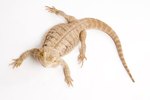Warnings
Read all manuals included with your incubator or automatic egg rotator before use. If the instructions differ in any way from the information provided here, follow the device's instructions.
In the wild, an emu will incubate and hatch its own eggs, sitting on and guarding them. They will do the same on your farm, as well — but you can also remove the eggs and incubate them yourself. Relieved of their parenting responsibilities, your emu will continue to breed, supplying you with a larger number of eggs than under normal conditions.
Place the emu eggs in your incubator. The temperature needs to be set to between 96.5 to 97.0 degrees Fahrenheit. As you can see, the temperature at which emu eggs need to be incubated is very precise — the necessary humidity level is somewhat less so. Anywhere between 70 to 75 degrees will be fine.
Rotate the eggs two to three times a day, using either an automatic egg rotator or by hand (lightly marking an X on the egg in pencil will help you remember whether an egg has been rotated).
Egg rotation should be stopped somewhere between day 40 and day 47, as the chicks prepare to emerge from their shells. After 43 to 50 days of incubation, the eggs will hatch, and your emu chicks will enter the world.
References
Warnings
- Read all manuals included with your incubator or automatic egg rotator before use. If the instructions differ in any way from the information provided here, follow the device's instructions.
Writer Bio
Mark Keller has been writing everything from short stories to political commentary over the course of the past decade. He has written professionally since 2009 with articles appearing on LibertyMaven.com, Penguinsightings.org, Pepidemic.com and various other websites. He is a theater major at Hillsdale College in Michigan.





